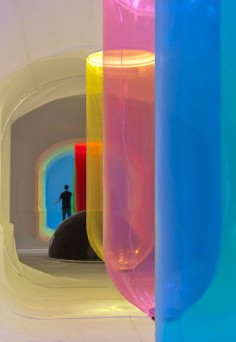Plastique Fantastique and Marco Barotti
SOUND of LIGHT
source: europaconcorsi
Imagine hearing the colours you perceive.
SOUND of LIGHT is a synesthetic sculpture which interprets and dynamically transforms sunlight into audio frequencies. It is a site specific installation designed for the former music pavilion in Hamm, Germany, which was built in 1912.
A high quality digital camera mounted on the top of the structure films the sky and divides it into six colours, RGB and CMY. The six hanging, coloured columns of the pneumatic structure, which stand for the primary RGB (red/green/blue) and secondary CMY (cyan/magenta/yellow) colour models, are designed to receive different frequencies and convert them from visible to audible sensory input. A series of woofers is fixed directly on the bottom of each column and convert the whole architecture into a giant vibrating loudspeaker.
SOUND of LIGHT is a composition of hue, saturation, and light. By mixing sound and architecture, the audience experience a unique oneiric reality through the superimposition of colours, shapes, sounds and vibrations. Visitors can also discover their own concert by changing their point of view – an individual spectrum.
.
.
.
.
.
.
.
source: designboom
imagine if you could hear the colors you perceive. you would be able to translate the green leaves of your garden, the black tar of your road, or the warm wood of your table into something audible. you wouldn’t just be able to see the vibrance of their physical representations, but another bodily sense would be engaged, enhancing your overall awareness of your surroundings. ‘sound of light’ is the site specific project of marco barotti and plastique fantastique for a former music pavilion at urban lights ruhr 2014 in germany that provides this effect.
the concept appears as a synesthetic sculpture which interprets and dynamically transforms sunlight into audio frequencies. a high-quality digital camera mounted on the top of the structure films the sky and divides it into six parts – RGB and CMY. the six corresponding columns of the pneumatic building – which stand for the primary (red, green, and blue) and secondary (cyan, magenta, yellow) color models – are designed to receive different oscillations and convert them from visible to audible sensory inputs. a series of woofers is fixed directly on the bottom of each suspended inflatable, converting the whole architecture into a giant vibrating loudspeaker.
‘sound of light is a composition of hue, saturation, and light. by mixing sound and architecture, the audience experience a unique oneiric reality through the superimposition of colors, shapes, sounds and vibrations. visitors can also discover their own concert by changing their point of view – an individual spectrum.’ – plastique fantastique.
.
.
.
.
.
.
.
source: exspacepl
Wyobraźcie sobie, że słyszycie kolory, które postrzegacie. Będziecie w stanie przełożyć na dźwięki: zieleń liści w ogrodzie, czerń asfaltu na swojej drodze lub ciepły odcień drewna waszego stołu. Nie tylko będziecie w stanie poczuć wibracje ale możecie zobaczyć fizyczność ich brzmienia. ‘Sound of Light’ to specyficzny projekt pawilonu muzycznego autorstwa Marco Barottiego i Plastique Fantastique zrealizowany na Urban Lights Ruhr 2014 w Niemczech, który ten efekt zapewnia. Interpretuje i dynamicznie przekształca światło słoneczne w częstotliwości dźwięku.
SOUND of LIGHT is a joint project of Marco Barotti and Plastique Fantastique for Urban Lights Ruhr 2014 in Hamm. Concept: Marco Canevacci, Marco Barotti Team: Mirjam Dorsch, Àlvaro Gómez-Sellés, Stephanie Grönnert, Hugo Luque, Michel Morin, Simone Serlenga, Valentin Sommer, Gabriel Spera, Yena Young Thanks: Katja Aßmann Photos: Marco Canevacci, Simone Serlenga Video: Camilla Mantovani
Na szczycie struktury zamontowany był wysokiej jakości aparat cyfrowy, który filmował kolory i przekształcał je na sześć skłądowych – RGB i CMY. Sześć kolumn pneumatycznego budynku – odpowiadających kolorem barwom podstawowym (czerwony, zielony i niebieski ) i dopełniającym (cyan, magenta, żółty) – zostało zaprojektowanych w taki sposób, by odbierały różne drgania i przekształcały je z widocznych w doznania dźwiękowe. Szereg niskotonowych głośników było zamocowanych bezpośrednio w dolnej części każdej podwieszonej pneumatycznej kolumny, przekształcając całą architekturę w jeden, wielki wibracyjny głośnik.


